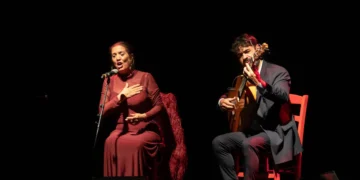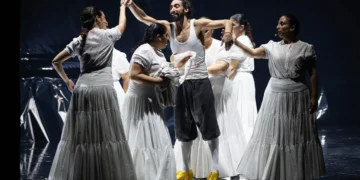Like finely aged brandy
|
Whenever I take the local train to Cádiz and we pass through Puerto de Santa María, I can’t help imagining a skinny adolescent years ago, born in La Línea but brought up in El Puerto, strolling around the street, bumping into his buddies… Rancapino, Juanito Villar, Gitanillo de Bronce, Camarón of course, the youngest of the crowd…that fertile generation of singers from around Cádiz who always looked up to Manolo Caracol, but never ignored the heritage of Aurelio Sellé, Manolo Vargas and other stars of a golden age, while at the same time presaging the shape of things to come. Fast forward to the new millennium. That singer, José Cortés Jiménez, has just recorded a CD, “Un Canto a la Libertad”. Now his portly presence is more in keeping with that rich flamenco voice he’s had since his youth and which was always so fascinating. Pansequito’s impact in those years was such that his bulería “Tápame tápame” symbolized the early 1970’s of flamenco just as much as Camarón’s “Al verte las flores lloran”. Indeed, conversations among flamenco fans in those days would often center around an obligatory side-taking, the way football fans in this country must decide between Barcelona and Madrid: “Camarón or Pansequito, which one are you for?” Thanks to the independent production of Antonio Benítez and Bujío Producciones, because the big record companies have practically abandoned flamenco, we are able to enjoy the magnificent maturity of one of the most interesting flamenco singers of the last half century. The sixty-something cantaor sets a good example of how flamenco can be reinvented day after day without abandoning the forms that make such evolution possible.
1 A quién le dejo mi voz (Bulerías) |
This is not a record which is free of commercial concessions, but lovers of classic flamenco won’t be disappointed either. Guest artists Miguel Poveda, Raimundo Amador, Moraíto, Niño de Pura, Diego Amaya and Aurora Vargas are great assets, as are the original verses of Diego Vargas, the singer’s son.
Pansequito’s alegrías and cantiñas have always been top of the line. In “Vive una gitana negra”, the characteristic sweetness of these cantes from the bay of Cádiz, their capacity to accommodate new melodies and the mystery of Pansequito’s way of singing once again come together successfully. In the soleá “Dime quién tiene sentido”, halfway between soleá por bulería and soleá, the singer’s richly textured voice is perfect for expressing the specific personality of this noble form: assimilated and dissimulated pain is more poignant than that which is expressed with histrionic shouting and clenched fists.
In siguiriyas, “Cuando me Acuerdo de ti”, the unmistakable guitar of Moraíto envelopes the listener in the flavor of Jerez, enhancing the expressive depth of a singer who puts his seal of originality on everything he touches. For tarantos, “Levántate mal acostado”, a cante Pansequito has always cultivated to west Andalusian taste, the beautiful accompaniment of Niño de Pura is just the right touch. The curiosity of a “tango” rociero in three quarter time, with the collaboration of Aurora Vargas, includes the first fandango de Huelva José Cortés has recorded.
Four bulerías in a variety of flavors, as is only fitting from this maestro of bulerías. “A quién le dejo mi voz” is a fine song, but the elaborate arrangement subtracts spontaneity. Why tie down this kind of creative talent with sheet music? Much more interesting is “María Elena”, a delightful song reminiscent of Canalejas, with Moraíto sparkling in the accompaniment. Miguel Poveda begins, then Pansequito lays down an Extremeñan bulería and other interesting odds and ends, courtesy of this veteran with his trademark elongations of certain vowels that bother some people, but others are craaaaaazy about. Instinctive whip-crack compás keeps it all on track.
“No me importa lo que digan” is a well-structured ballad to fiesta compás, although again the silky arrangement sabotages the energy. Another bulería song, “Los galanes”, in which Pansequito cultivates a Camarón/Potito delivery not usual in him, seems directed at the disco crowd, as can also be said of the rumba with the collaboration of Las Peligros, “Las gitanas me dicen”, which provides no challenge for this grizzled lion of a singer, although it does sound good. Just as it would sound good if he sang the happy birthday song. There are privileged voices that grab you and don’t let go. This is one of them.
Descubre más desde Revista DeFlamenco.com
Suscríbete y recibe las últimas entradas en tu correo electrónico.




























